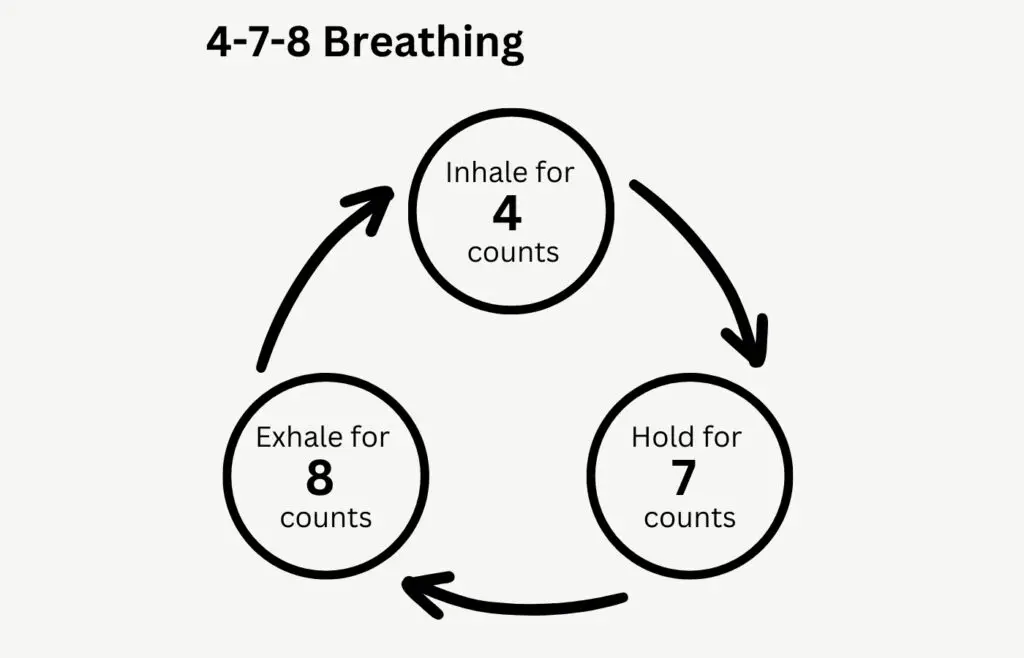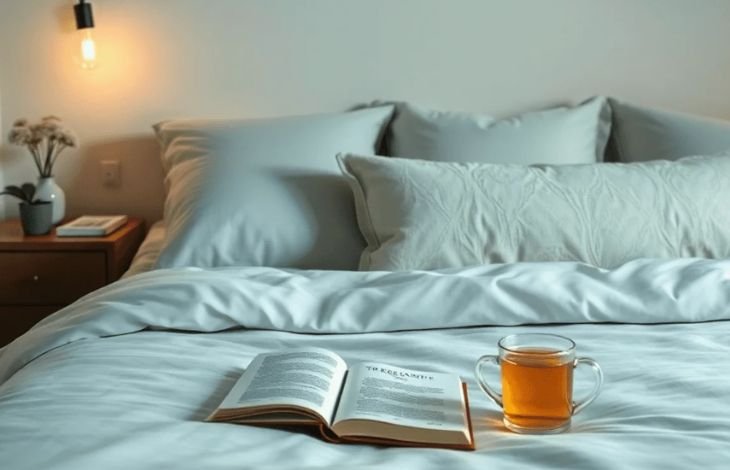
We’ve all been there, haven’t we? Those nights when sleep seems to elude us no matter how much we toss and turn and the clock on the bedside table mocks us with every passing minute.
Perhaps you’ve tried counting sheep, or maybe you’ve sampled every type of herbal tea on the market. But have you ever considered trying breathing exercises for sleep?
Yes, that’s right—using your breath in specific and intentional ways can help you fall asleep faster and enjoy more restful and rejuvenating slumber.
Getting a good night’s rest is absolutely vital for our overall well-being. It’s not just about waking up feeling rejuvenated and prepared to tackle whatever comes our way.
High-quality sleep goes beyond that – it plays a critical role in our cognitive function, mood regulation, physical health, and even impacts our immune system, heart health, and weight management.
The Power of Breathwork
So where does breathing come into play? Well, your breath is intimately connected with your nervous system—the part of your body that, among other things, helps you relax.
Certain deep breathing exercises can activate your parasympathetic nervous system (your body’s “rest and digest” functions), helping to slow your heart rate and usher in the relaxation needed for quality sleep. These exercises can help calm your mind, relax your body, and get you ready for a peaceful night’s sleep.
The beauty of using breathwork to improve sleep is that it doesn’t require any special equipment or significant time commitment. You can do these exercises lying in bed, ready to fall asleep.
And with practice, you might find they become a soothing part of your bedtime routine—a signal to your body and mind that it’s time to let go of the day’s worries and embrace the restorative power of sleep.
If you are new to breathwork, or just eager to learn more, check out our article “How To Harness The Power Of Breathing: The Beginner’s Guide“.
So, if you’re tired of tossing and turning all night, why not give these breathing exercises a try?

Incorporating Breathwork into Your Bedtime Routine for Deeper, More Restful Sleep
When it comes to getting good sleep, it’s important to be consistent. Having a regular bedtime routine can tell your body that it’s time to relax and get ready for bed. And one thing you can add to this routine is breathing exercises for sleep.
Breathwork can help calm your mind and body, making it easier to fall asleep and stay asleep. Plus, it’s something you can do anywhere, anytime, without any special equipment.
Creating a Calm Sleep Environment
Before we dive into the specific breathing techniques, let’s talk about creating the right atmosphere for sleep. Here are some tips:
Keep your bedroom clean and clutter-free. A tidy space can help clear your mind and reduce stress.
Regulate room temperature. A cooler room (around 60-67 degrees Fahrenheit/ 16-19 degrees celcius) is generally better for sleep.
Dim the lights or use soft, warm lighting options before bed.
Consider using calming scents like lavender or chamomile which are known for their soothing properties.
By making these changes, you can turn your bedroom into a peaceful sanctuary that promotes relaxation.
Using Technology Wisely
Technology can be both a blessing and a curse when it comes to sleep. While excessive screen time before bed can disrupt your sleep patterns, some digital tools can actually help you wind down.
For example, there are wonderful apps like Breethe, Calm or Headspace that offer guided breathing exercises and relaxing sounds specifically designed to help you sleep. These can be useful, especially if you’re just starting out with breathwork.
However, it’s important to remember that these apps should complement your natural instincts, not replace them. While they can be helpful in teaching you new techniques, ultimately, you should listen to your own body and do what feels right for you.

7 Breathing Exercises For Sleep
Now that we’ve set the stage for better sleep, let’s explore some simple breathing exercises that you can incorporate into your bedtime routine.
These techniques are easy to learn and can be done in bed, right before you’re ready to sleep, or even if you wake up in the middle of the night.
Remember, incorporating breathwork into your bedtime routine is all about finding what feels good and natural for YOUR body. Everybody is different, also when it comes to the preferred breathing exercises for improving your sleep.
By experimenting with different techniques and paying attention to how your body responds, you’ll be able to develop a personalized breathwork practice that aids in relaxation and promotes better sleep.
So whether it’s the gentle rhythm of box breathing or the deep, slow breaths of the 4-7-8 technique, don’t be afraid to explore and find what works best for you.
1. 4-7-8 Breathing Technique with Sleep-Promoting Soundscapes
What is the 4-7-8 Breathing Technique?
The 4-7-8 breathing technique is a simple, yet powerful, relaxation method derived from yoga practices. This deep rhythmic breathing technique has the potential to reduce anxiety and promote relaxed sleep by activating the parasympathetic nervous system, which in turn relaxes the brain, decreases heart rate and blood pressure, and increases melatonin levels.
How to Practice the 4-7-8 Breathing Technique for Sleep
Here’s a step-by-step guide to this sleep-inducing breathing exercise:
Sit or lie down comfortably and close your eyes.
Inhale quietly through your nose for a count of 4.
Hold your breath for a count of 7.
Exhale forcefully through your mouth, making a whoosh sound, for a count of 8.
This completes one breath cycle. Repeat this cycle 4-8 times or until you start feeling more relaxed.
By focusing on this pattern, you can effectively shift your attention away from thoughts, stressors, and worries, preparing your mind for sleep.

Experience the Symphony of Breath and Sound
Pairing the 4-7-8 breathing technique with relaxing soundscapes can enhance its calming effects. The addition of sleep-promoting soundscapes helps create an immersive environment conducive to relaxation and restful sleep.
Consider these options to accompany your practice:
Rainfall: The rhythmic pattern of raindrops can mimic the rhythm of calm, deep breathing.
Ocean Waves: The ebb and flow of waves can mirror inhalation and exhalation.
Forest Sounds: The gentle rustling of leaves or distant bird calls can help create a peaceful atmosphere.
Remember that the key to effective breathwork for sleep is regular practice.
As you continue with this routine, you may find that your sleep improves and that you’re better able to handle the stressors of daily life.
2. Diaphragmatic Breathing Exercise Enhanced with Soothing Sounds
Let’s explore the exercise of Diaphragmatic Breathing for better sleep. This method, also known as belly breathing, focuses on the diaphragm – a key muscle involved in breathing.
By practicing this type of breathwork, you can effectively reduce stress and promote relaxation, both essential for a restful night’s sleep.
To begin, follow these easy steps:
Find a comfortable position in your bed.
Place one hand on your chest and the other on your belly.
Breathe in slowly through your nose, allowing your belly to rise as it fills with air.
Exhale gently through your mouth, noticing how your belly falls.
Repeat this process for several minutes or until you start to feel sleepy.
Adding calming sounds to this exercise can make it even more relaxing. When you use auditory cues, it creates a peaceful environment that makes it easier to fall asleep and stay focused without getting distracted.
Some recommended soothing sounds to accompany diaphragmatic breathing include:
Pink and white noises can be helpful for sleep, as they block out external sounds.
Green and brown noises are thought to help with falling asleep, and brown noises are thought to help with staying asleep a little better.
Sounds of nature like the gentle rustling of leaves and chirping of birds are like a soothing lullaby that can greatly enhance your sleep.

Remember, everyone has their own preferences when it comes to soothing sounds, so don’t be afraid to try out different options until you find what works best for you.
Next time you’re having trouble falling asleep, give diaphragmatic breathing a go. As you take slow, deep breaths into your belly and release them slowly, let the peaceful sounds of nature transport you into dreamland.
3. Alternate Nostril Breathing Technique with Theta Waves and Rain Sounds
The alternate nostril breathing technique, also known as Nadi Shodhana in the yoga tradition, is a powerful practice that promotes balance and tranquility.
This method is believed to harmonize the two hemispheres of the brain, resulting in a calm and balanced mental state, perfect for easing into a restful night’s sleep.
Step-by-Step Guide to Alternate Nostril Breathing Technique:
Find a Comfortable Position: Sit comfortably with your spine straight. Relax your shoulders away from your ears. Alternatively you can lie down in your bed.
Gently Close Your Right Nostril: Use your right thumb to close off the right nostril.
Inhale Slowly Through Your Left Nostril: Take a deep and slow breath in.
Switch Nostrils: Close your left nostril with your fingers and release the thumb from your right nostril.
Exhale Through Your Right Nostril: Slowly breathe out through the right side.
Inhale Through Your Right Nostril: With the left still closed, breathe in deeply on the right side.
Switch Again: Close off the right nostril and exhale through the left.
Continue the Cycle: Repeat this pattern for several minutes, finishing on an exhale through the left nostril.

To enhance this already soothing exercise, incorporating theta waves and rain sounds can deepen relaxation further:
Theta Waves: These sound frequencies are often associated with deep relaxation and meditation states. They can encourage a more profound mental synchronization conducive to sleep.
Rain Sounds: The rhythmic pattern of rain provides a natural white noise that can mask distracting sounds while promoting inner calm.
Pairing alternate nostril breathing with these auditory elements creates an immersive atmosphere that allows stress to melt away and invites quality sleep. Simply play theta wave audio or rain sounds in the background as you practice this technique before bedtime.
Remember, like any skill, mastery of alternate nostril breathing grows over time and consistent practice can yield even greater benefits for sleep quality and overall well-being.
4. Progressive Muscle Relaxation Combined with Breathing Exercises For Sleep
Progressive muscle relaxation is a technique that involves tensing and then relaxing different muscle groups in the body. This helps promote a state of calmness and can help you fall into a deep sleep. It’s effective because it targets physical tension, which can often prevent sleep.
How to Practice Progressive Muscle Relaxation with Breathwork:
Find a Comfortable Position: Lie down in your bed or sit in a cozy chair, ensuring your body feels supported.
Breathe Deeply: Start by taking slow, deep breaths to initiate a state of relaxation.
Clench and Release: Begin at your feet and work your way up the body. Clench each muscle group tightly for about five seconds.
Exhale and Relax: As you release the tension, exhale slowly and imagine the stress leaving your body with the breath.
Pause: After relaxing each muscle group, pause to enjoy the sensation before moving to the next group.
Work Upward: Continue the process with each muscle group—legs, abdomen, chest, arms, and face.
Full Body Release: Once you’ve worked through all areas, take a few moments to breathe and feel the weight of your relaxed body.

Pairing this practice with a guided session can greatly enhance its effectiveness. As a suggestion, the app Calm’s “Soften Into Sleep” guided session is crafted to lead you through progressive muscle relaxation while integrating calming breathwork:
The guidance helps maintain focus on relaxation rather than on daily stressors.
A soothing voice can direct attention away from intrusive thoughts that often impede sleep.
The structured approach ensures no muscle group is overlooked, contributing to full-body relaxation.
By incorporating progressive muscle relaxation into your nightly routine, you invite deeper levels of restfulness. It’s like giving your body permission to let go of the day’s burdens, one muscle at a time, easing into a restorative night’s sleep.
5. Box Breathing with Visualization
Box breathing, also known as square breathing or four-square breathing, is a simple yet powerful and calming breath exercise. It helps to calm the mind, reduce stress, and improve concentration.
This technique is commonly used by athletes, Navy SEALs, and police officers to stay calm in high-pressure situations.
Here’s how it works: Imagine a box in your mind. Each side of the box represents one stage of the breathing cycle – inhale, hold, exhale, hold. Imagine tracing the shape of the box as you breathe. Each stage is done for an equal length of time.
Now let’s break it down step by step:
Inhale: Breathe in deeply through your nose for a count of four. Feel your lungs filling up with air, tracing across the top of the box.
Hold: Keep the air in your lungs and count to four, as you go down one side of the box.
Exhale: Slowly release the air through your mouth while counting to four, tracing across the bottom of the box.
Hold: Pause for another count of four as you go up the other side, completing the box.

Repeat this cycle a few times – try for at least five minutes if you can. The beauty lies in its simplicity; you don’t need any special equipment or environment to practice box breathing.
Adding calming sounds to this exercise can really take it to another level. Consider using the soothing sounds of a campfire, creek flows, or forest ambiance to create a peaceful sleep environment.
These natural sounds can help you relax, improve your mental focus, and reduce any disruptions during your rest. Check out the app Breethe’s wide selection of sounds favorable for sleep.
Remember that like any new skill, it may take some practice before you feel completely comfortable with box breathing. So be patient with yourself and make this part of your regular bedtime routine for optimal results.
Box breathing serves as a quick and efficient way to lower stress levels and prepare your body for a good night’s sleep. So nestle into your comfy pillows and let’s move on to exploring more mindful breathing for better sleep!
6. Bhramari Pranayama (Humming Bee Breath) for Stress and Anxiety Reduction at Bedtime
Bhramari Pranayama — also known as the Humming Bee Breath — is an effective breathing technique from the yogic tradition that fosters a tranquil state of mind, making it ideal for bedtime. The soothing hum creates a calming influence on the nervous system, helping to reduce stress and anxiety levels.
The Science Behind Bhramari Pranayama
Studies suggest that this technique can stimulate the parasympathetic nervous system — which aids relaxation — and suppress the sympathetic nervous system, often associated with stress and the fight-or-flight response.
This balance between both systems enhances your overall well-being and prepares your body and mind for a good night’s sleep.
A Step-by-Step Guide to Bhramari Pranayama
Sit comfortably with your eyes closed.
Place your index fingers on your ears, there’s a cartilage between your cheek and ear. Gently press that cartilage.
Breathe in slowly through the nose.
As you exhale, make a gentle humming sound like a bee.
Repeat this cycle five to ten times.

While practicing Bhramari Pranayama, focus on the resonance of the humming sound throughout your body. It might feel as though your whole body is vibrating in sync with your breath; this sensation can help deepen relaxation.
Incorporating Bhramari Pranayama into your nighttime routine can greatly aid in reducing stress and anxiety before sleep. Give it a try tonight and experience the soothing effects of this ancient breathing practice!
7. Kumbhaka: Extended Breath Retention to Induce Relaxation Before Sleep
Kumbhaka, an ancient yogic technique, stands out as a powerful tool for sleep induction. It involves manipulating the breath by extending the pauses between inhalation and exhalation.
By holding the breath in these periods, Kumbhaka can lead to profound states of relaxation and balance energy in the body.
This technique has two types: Antar Kumbhaka, where you hold your breath after inhaling, and Bahya Kumbhaka where you hold it after exhaling.
Here we will focus on Antar Kumbhaka due to its deep calming effect suitable for sleep preparation.
Here’s a step-by-step guide to practicing Antar Kumbhaka:
Find a quiet and comfortable space: Make sure your environment is conducive for relaxation.
Sit comfortably: You can either sit cross-legged on the floor or on a chair ensuring your back is straight.
Start with normal breathing: Take a few moments to breathe naturally, allowing your body and mind to relax.
Inhale Deeply: Take a deep breath in, filling your lungs completely.
Hold Your Breath: Hold your breath inside for a count that feels comfortable for you. Start with a short count like 4 or 5 seconds and gradually increase over time as you become more comfortable.
Exhale Slowly: After holding your breath, exhale slowly and completely before starting the next cycle.

Remember not to force or strain yourself when holding your breath. The key is patience and practice – over time, you’ll be able to hold your breath for longer periods comfortably.
Kumbhaka can be an effective way of calming the mind before sleep due to its ability to trigger the body’s natural relaxation response. Embrace this technique as a part of your nightly routine, and you’ll soon notice a deeper, more restful sleep.
The Wrap Up
Starting on the path of breathing exercises for sleep can be a game-changer for anyone looking to improve their sleep and overall well-being.
The positive effects of such a practice go beyond just the night, providing a refreshed awakening and a more balanced state of being throughout the day.
Long-Term Benefits:
Improved sleep quality leads to better focus, mood, and energy levels
Regular breathwork supports stress reduction and emotional resilience
A strengthened mind-body connection fosters greater mindfulness and presence
Personal Exploration:
Try out different techniques to discover what works best for you
Listen to your body’s response; it’s the best indicator of what you need
Remember, consistency is important – make breathing exercises a regular part of your nightly routine
By incorporating these practices into your life, you create the conditions for peaceful nights and energized days.
Enjoy the journey and have pleasant dreams!
Have any questions?
If you have any questions about breathwork or how the exercises work, leave a comment below!






2 Comments
Gina P
28/04/2024 at 8:51 PM
These tips are great!
breatheintocalm.com
01/05/2024 at 2:20 AM
Good to hear you like them Gina. Just being conscious of our breathing might be enough to take our minds off the stuff that fills our days so we can find rest at night. It’s pretty neat 🙂